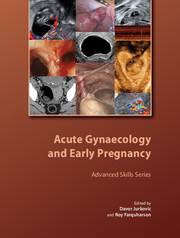Book contents
- Frontmatter
- Contents
- About the authors
- Acknowledgements
- Abbreviations
- Preface
- 1 Organisation and delivery of emergency care in early pregnancy and acute gynaecology
- 2 Epidemiology and aetiology of miscarriage and ectopic pregnancy
- 3 Diagnosis of miscarriage
- 4 Conservative and surgical management of miscarriage
- 5 Management of hyperemesis gravidarum
- 6 Diagnosis and treatment of recurrent miscarriage
- 7 Differential diagnosis and management of molar pregnancy
- 8 Drugs in early pregnancy
- 9 Diagnosis of tubal ectopic pregnancy
- 10 Conservative management of tubal ectopic pregnancy
- 11 Surgical management of tubal ectopic pregnancy
- 12 Diagnosis and management of non-tubal ectopic pregnancy
- 13 Diagnosis and management of acute pelvic pain
- 14 Management of vaginal bleeding in the acute clinical setting
- 15 Current concepts in screening and outpatient management of pelvic inflammatory disease
- 16 Diagnosis and management of haemorrhagic and septic shock
- 17 Role of minimally invasive surgery in acute gynaecology
- Index
6 - Diagnosis and treatment of recurrent miscarriage
Published online by Cambridge University Press: 05 July 2014
- Frontmatter
- Contents
- About the authors
- Acknowledgements
- Abbreviations
- Preface
- 1 Organisation and delivery of emergency care in early pregnancy and acute gynaecology
- 2 Epidemiology and aetiology of miscarriage and ectopic pregnancy
- 3 Diagnosis of miscarriage
- 4 Conservative and surgical management of miscarriage
- 5 Management of hyperemesis gravidarum
- 6 Diagnosis and treatment of recurrent miscarriage
- 7 Differential diagnosis and management of molar pregnancy
- 8 Drugs in early pregnancy
- 9 Diagnosis of tubal ectopic pregnancy
- 10 Conservative management of tubal ectopic pregnancy
- 11 Surgical management of tubal ectopic pregnancy
- 12 Diagnosis and management of non-tubal ectopic pregnancy
- 13 Diagnosis and management of acute pelvic pain
- 14 Management of vaginal bleeding in the acute clinical setting
- 15 Current concepts in screening and outpatient management of pelvic inflammatory disease
- 16 Diagnosis and management of haemorrhagic and septic shock
- 17 Role of minimally invasive surgery in acute gynaecology
- Index
Summary
Introduction
Miscarriage is the most common complication of pregnancy, with as many as 15-20% of clinically recognised pregnancies ending in spontaneous failure. The main causes of miscarriage are sporadic lethal chromosomal abnormalities and these pregnancies are destined to fail from the outset. In fact, if all conceptions were included in the definition of miscarriage, around 40% would end in failure, with the majority occurring before the pregnancy could be clinically recognised.
However, in some couples, miscarriage can be recurrent, which is defined as three consecutive pregnancy losses before fetal viability at 24 weeks of gestation. The prevalence of this condition is approximately 1%. As the most common cause of miscarriage is aneuploidy, which is directly related to maternal age, the risk and prevalence of early pregnancy loss rises with increasing maternal age. The overall prevalence of recurrent miscarriage in the population is higher than would be expected by chance alone. Statistically, the prevalence should be only 0.34%, indicating that in some couples there may be an underlying cause that puts them at higher risk. However, the calculation of the risk of three consecutive losses is based on the assumption that the baseline risk of miscarriage is 15%. This calculation does not take into account the fact that the risk of miscarriage increases with advancing maternal age. For example, the risk of miscarriage in a 40-year-old woman is at least 45% and therefore the expected prevalence of recurrent miscarriage in this age group is approximately 9%.
- Type
- Chapter
- Information
- Acute Gynaecology and Early Pregnancy , pp. 63 - 72Publisher: Cambridge University PressPrint publication year: 2011
- 1
- Cited by



